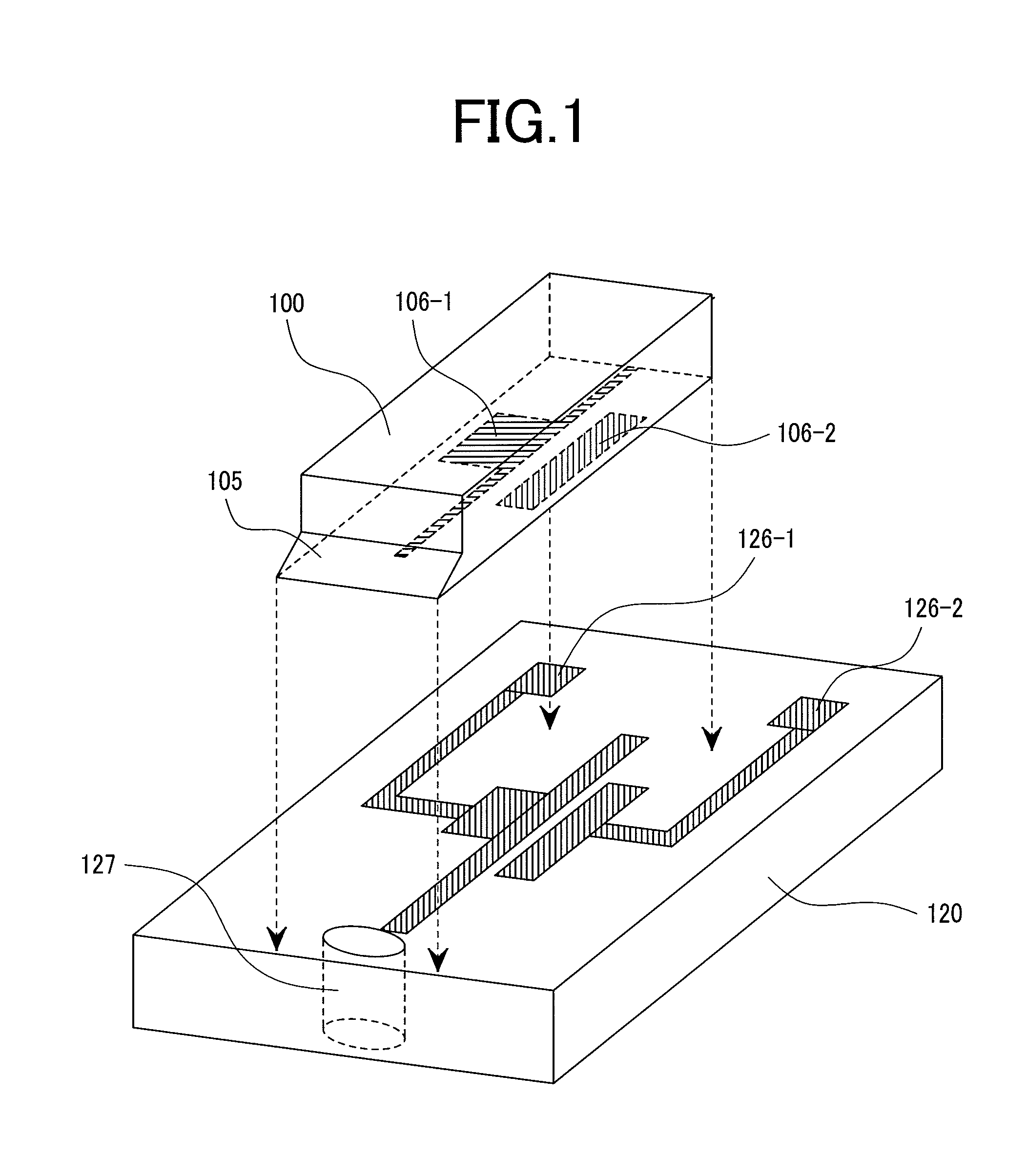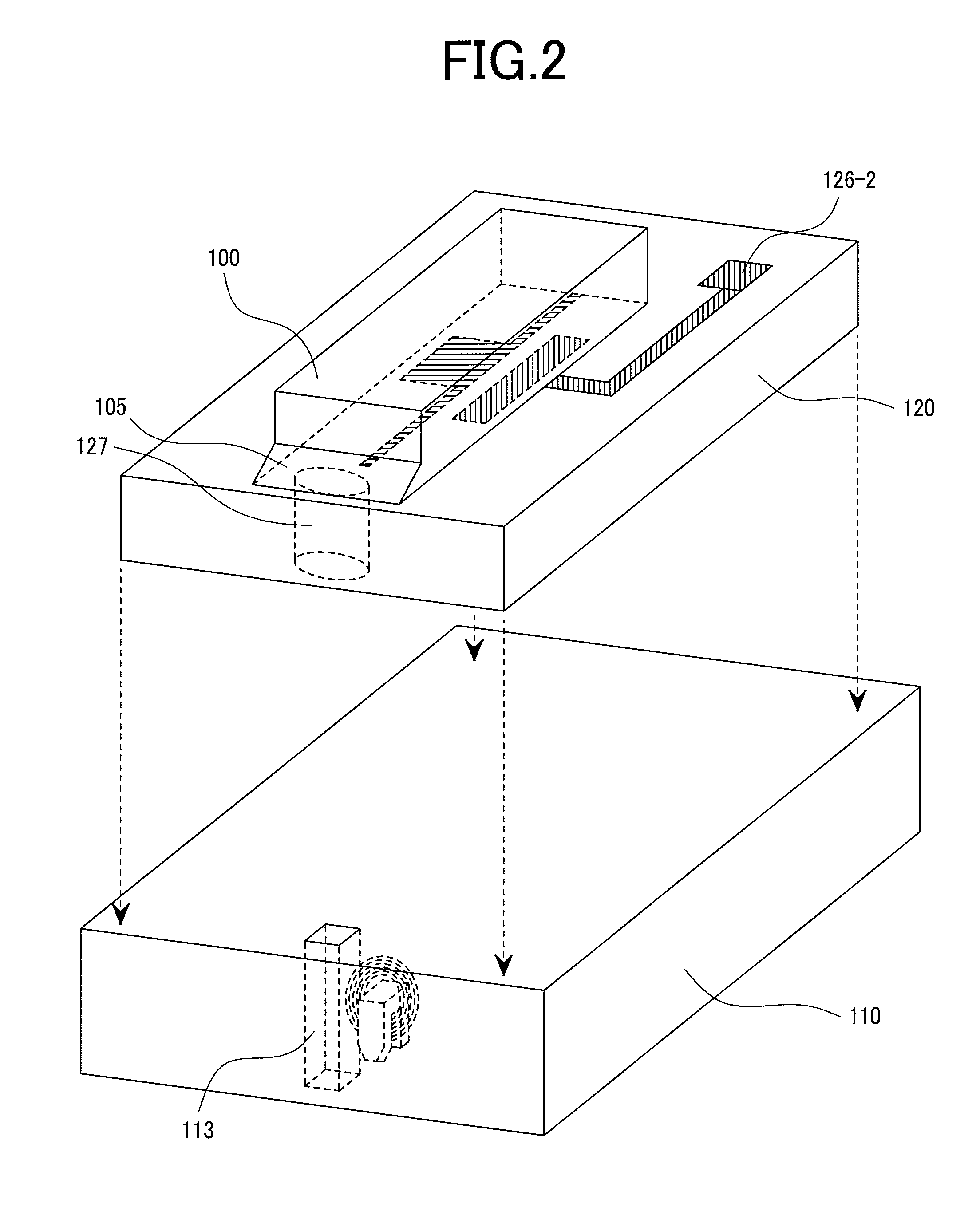Optical device integrated head
a technology of optical devices and integrated heads, which is applied in the field of optical device integrated heads, can solve the problems of difficult to eliminate the propagation loss, limit the practical decrease of optical loss, and difficulty in achieving the constitution of decreasing the propagation loss, so as to reduce the optical loss, reduce the former optical loss, and reduce the effect of scattering
- Summary
- Abstract
- Description
- Claims
- Application Information
AI Technical Summary
Benefits of technology
Problems solved by technology
Method used
Image
Examples
embodiment 1
[0070]FIG. 3 shows a preferred embodiment of the invention. This is a perspective view schematically showing an optical device integrated head manufactured by mounting a semiconductor laser diode having a reflection mirror monolithically integrated thereon to a submount and mounting the submount on a slider. FIG. 4A is a view showing a cross section of a laser diode along the direction of a cavity. FIG. 4B shows a perspective view of a magnetic transducer and coils to be mounted in FIG. 4A.
[0071]A laser diode has a monolithically integrated reflection mirror 105, and emits a light from a light emission surface 107. A laser diode 100 is mounted to the first surface 121 of a submount 120 in such a positional relation that a light transmits a structure 127 for allowing the light of the submount to pass therethrough. Electric leads 126 (126-1, 126-2) for driving the laser diode are disposed on the first surface 121 of the submount 120 and mounted being welded to electrodes 106 of the la...
embodiment 2
[0078]FIG. 5 is a perspective view schematically showing an optical device integrated head manufactured by mounting a semiconductor laser diode having a monolithically integrated reflection mirror on a submount as an embodiment of the invention and mounting the submount on a slider. FIG. 6A is a view showing a cross section of a laser diode along the direction of a cavity. FIG. 6B shows a perspective view for a magnetic transducer and coils to be mounted in FIG. 6A.
[0079]This embodiment is different from the embodiment 1 in view of the structure of the submount. In this structure, a submount 120 is cut to form a micro-lens structure 129. For a light transmitting structure 127, a material transparent to the emission wavelength of a laser diode, that is, a material having a large band gap may be used.
embodiment 3
[0080]FIG. 7 is a perspective view showing a structure of attaining active alignment by using a laser diode, a reflection mirror, a submount, and a slider as a preferred embodiment of the invention. FIG. 8A is a view showing a cross section of a laser diode along the direction of a cavity. FIG. 8B is a perspective view of a magnetic transducer and coils to be mounted in FIG. 8A.
[0081]Active alignment is conducted by using an edge-emitting laser diode 10 and a reflection mirror 131 for converting the propagating direction of a light of the laser diode instead of the surface emitting laser diode having the mirror integrated to the laser diode of the embodiment 1 to conduct mounting. With a viewpoint of a mounting space, a lens structure 132 is integrated with the mirror. It is simple and convenient to fix the mirror 131 to a groove 128 in the submount upon mounting the laser diode 10 and the reflection mirror 131 on the submount 120. Since the example of the mirror shown in the drawin...
PUM
| Property | Measurement | Unit |
|---|---|---|
| angle | aaaaa | aaaaa |
| angle | aaaaa | aaaaa |
| angle | aaaaa | aaaaa |
Abstract
Description
Claims
Application Information
 Login to View More
Login to View More - R&D
- Intellectual Property
- Life Sciences
- Materials
- Tech Scout
- Unparalleled Data Quality
- Higher Quality Content
- 60% Fewer Hallucinations
Browse by: Latest US Patents, China's latest patents, Technical Efficacy Thesaurus, Application Domain, Technology Topic, Popular Technical Reports.
© 2025 PatSnap. All rights reserved.Legal|Privacy policy|Modern Slavery Act Transparency Statement|Sitemap|About US| Contact US: help@patsnap.com



